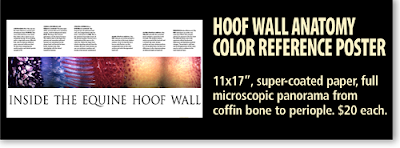 |
| Farrier Dean Dibsdall has been in the news in England lately for his victory in a reality last-man-standing show called "Playing It Straight". He also works as a model and next month will be the star of a documentary about...himself. (Photo courtesy of Horse and Country TV) |
And the next thing I knew, he was on a reality show similar to the USA's "The Bachelorette" but with a twist--some of the eligible bachelors were gay. But which ones? And was Dean gay or straight?
I honestly didn't know which he was, but I was cheering him on from the USA anyway.
Dean Dibsdall DipWCF ended up winning the "Playing It Straight" show (was it his burnt hoof after-shave?) and a lot of money. Now the British network Horse and Country is planning a documentary about what it's like to be a farrier celebrity--they'll even follow him when he competes in the farrier events at the National Shire Show in a few weeks.
When I played "do you know..." with Dean, I found that he could rattle off at least three names familiar to American farriers: he lives next to Billy Crothers; he was apprentice to Carl Bettison's second apprentice, Daniel Harman; and he has worked for James Blurton in the past. That seems like the start of a great resume, or like meeting your second cousin, twice-removed, for the first time.
In the farriery world, Dean is four years into his career and shoes horses around Hertfordshire, Bedfordshire and Buckinghamshire, all north of London.
 |
| Dean Dibsdall really does shoe horses. "Being a farrier and working with horses is the most important thing in my life," he said in an interview. (photo courtesy of Dean DIbsdall) |
Let's all celebrate his success and wish him well and hope that we can figure out a way to see the documentary in the USA.
Here's the press release from Horse and Country TV, and some information from the Hoof Blog files about other farrier models:
Dean Dibsdall, winner of Channel 4’s Playing It Straight series, is to be the subject of a documentary on Horse & Country TV (Sky Channel 280), it was announced today.
The hour-long show, Dean Dibsdall: Model Farrier, will be shown on the British channel in April.
Horse & Country’s cameras will follow Dean as he deals with his new-found fame while working as a specialist in horse hoof care. As well as being a full-time farrier Dean, 28, from Leighton Buzzard, also works as a part-time model. He won the title of "Mr Bedfordshire" last year and represented the county in the final of the "Mr England" competition.
“I’m very excited to be doing this show with Horse & Country TV,” says Dean, ”being a farrier and working with horses is the most important thing in my life.
“I hope fans of Playing in Straight will tune in and be really entertained while at the same time experience a world they wouldn’t normally get the chance to encounter.”
| Dean's not the first British farrier model; eventing specialist Jamie Goddard was model for the TeamGBR clothing line a few years ago. He shoes for riders like Australia's Paul Tapner, winner of Badminton Horse Trials in 2010. (Jamie Goddard photo) |
The show will highlight the tremendous variety of Dean’s professional life including working with miniature Shetland ponies, alongside vets to help lame horses, visiting a range of livery yards and taking part in a farrier competition at the Shire Horse Show as well as following his new experiences as a fledgling celebrity.
Dean has been a farrier for four years, following in a family tradition that has seen three of his cousins become farriers too. After setting his heart on working with horses Dean underwent more than four years of intensive training at college as well as shadowing a qualified farrier.
“I wasn’t sure what I wanted to do when I left school so one day went out with one of my cousins who was already a farrier and I just took to it straight away,” says Dean, ”It’s a physical job and you get to work with animals outdoors in the fresh air – plus you’re your own boss.”
Working in such close proximity to horses isn’t without its dangers but Dean says: “I’ve had a few broken bones and cracked ribs but you don’t mind when you’re doing something you love.”
 |
| British farrier Nick Partridge was the star of a full-page ad for Herring shoes in the magazine for the 2011 Ascot race meet. I thought it was a horseshoe ad. Fun to see such a well- shod farrier! |
If one of the gay contestants had successfully deceived Cara and been picked by her, he would have won the show’s £50,000 cash prize. Because she chose Dean, one of the genuinely straight contestants, the two of them split the prize, receiving £25,000 (approximately $40,000US) each.
The documentary has been commissioned by Jonathan Rippon, Head of Programming at H&C TV, and is being made in-house at H&C by the production team responsible for other series on the channel such as Top Marks, When Nicki Met Carl and magazine show Rudall’s Round Up.
 |
| Refresh your anatomy knowledge with a high-tech, easy-to-use animated 3-D lecture series and user-operated leg model. Order online! |
© Fran Jurga and Hoofcare Publishing; Fran Jurga's Hoof Blog is a between-issues news service for subscribers to Hoofcare and Lameness Journal. Please, no use without permission. You only need to ask. This blog may be read online at the blog page, checked via RSS feed, or received via a digest-type email (requires signup in box at top right of blog page). To subscribe to Hoofcare and Lameness (the journal), please visit the main site, www.hoofcare.com, where many educational products and media related to equine lameness and hoof science can be found. Questions or problems with this blog? Send email to blog@hoofcare.com.








